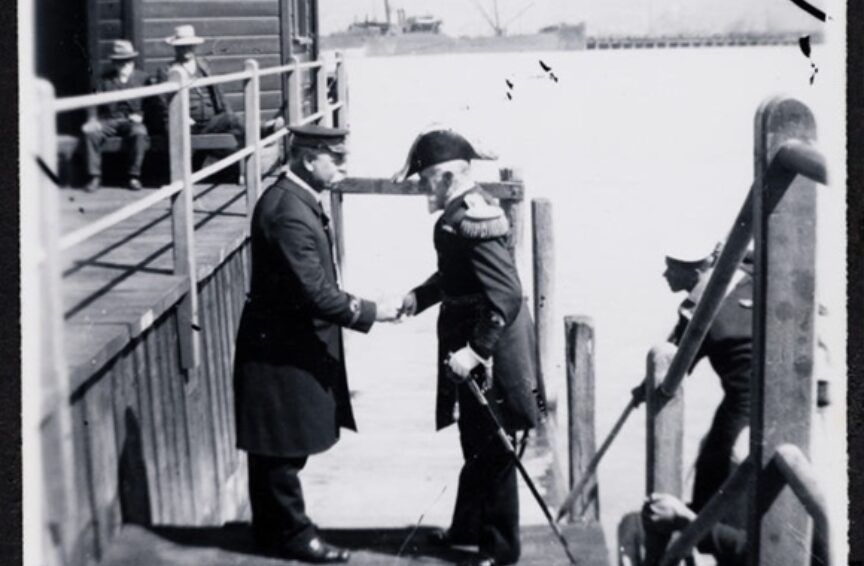PO Box 95
Lyttelton 8841
Te Ūaka recognises Te Hapū o Ngāti Wheke as Mana Whenua and Mana Moana for Te Whakaraupō / Lyttelton Harbour.
“Our Dreadnought” HMS "New Zealand"
In the early pre-dawn hours of Tuesday 13 May 1913, having braved a fierce southerly gale, the battlecruiser HMS New Zealand laid anchor off Camp Bay in Whakaraupō Lyttelton Harbour. The largest ship to have ever visited the port at that time, with the morning sun she was escorted to her berth by the Lyttelton tugs and greeted by large crowds of fervent New Zealanders who had gathered there to catch the first glimpse of “our Dreadnought”. Extra trains had been scheduled to cater for the expected throngs in what was billed as the ‘HMS New Zealand Festival Week’. Captain Lionel Halsey, formerly of the Royal Navy’s Australasian Station, and his officers including two lieutenants from Christchurch, Rupert Garsia and Alexander Boyle, were greeted on the wharf by local dignitaries. After formal pleasantries they were whisked off for a week of official functions that included a meeting with Prime Minister William Massey, a soccer match on the domain, a visit of 200 bluejackets for a cricket match at Ashburton, and a gala ball. Over the week of 13–22 May, many thousands of Cantabrians streamed into Lyttelton port to stand for hours in queues on the wharf for the opportunity to board and inspect ‘their’ battlecruiser.
Previously in 1909, in response to the growing threat of German aggression, New Zealand’s then Prime Minister Sir Joseph Ward ordered the construction of a modern battlecruiser to serve in the British Royal Navy. At a cost of £1.7 million ($333 million in 2022), HMS New Zealand was laid down at Fairfield’s in Govan, Scotland in 1910, launched in 1911, and commissioned into the Royal Navy in 1912. Although the New Zealand Naval Forces were formed in 1913, they remained a division of the British Royal Navy, initially under the command of the Australasian Station in Sydney before being transferred to the China Station, while HMS New Zealand remained in British waters at the request of the Admiralty.
Based on an update of the earlier Invincible class, the New Zealand was one of three Indefatigable class battlecruisers to be built, all designed for speed and manoeuvrability, with lighter armour and less guns than the Navy’s heavy battleships. Displacing up to 22,130 tons she was 179.9 m in length, with a beam of 24.4 m and an 8.2 m draught. Propulsion used 31 Babcock & Wilcox coal-fired boilers driving 4 steam turbines producing 44,000 shaft horsepower (33,000 kW) for a maximum speed of 25 knots (46 km/h) with a range of up to 6,690 nautical miles (12,390 km) at 10 knots (19 km/h). Her main armaments were four twin turrets with 12-inch (305 mm) guns placed fore, aft and midships, along with sixteen 4-inch (102 mm) guns and two 18-inch (457 mm) torpedo tubes. With a complement of up to 1070 crew, she was a pre-WW1 marvel of modern British military technology.
In 1913, HMS New Zealand had set sail for a 10 month circumnavigation that was to include a 10 week ‘thank you’ tour of His Majesty King George V’s New Zealand Dominion. Arriving at Wellington on 12 April 1913, she proceeded to call in at ports around the North Island to Auckland. From there she steamed down to Lyttelton, reaching Akaroa by mid-May, then on to Timaru and Dunedin, and back up the west coast to Auckland, finally departing on 28 June. Everywhere the battlecruiser went she was greeted by many thousands of people, with upwards of 378,068 visiting her in the various ports, and an estimated 125,000 viewing her by shore or boat, for a total of over 500,000 of the country’s then 1 million population, making this visit one of the most popular public spectacles in Aotearoa New Zealand’s history.
On her return, HMS New Zealand served with distinction through WW1 in the Royal Navy's Grand Fleet, opposing the Kaiser’s German High Seas Fleet in the North Sea battles of Heligoland Bight, Dogger Bank and Jutland. Taking part in the sinking of two German cruisers, she was hit only once suffering no casualties, and came to be known as the ‘lucky ship’ for her crew, allegedly due to the gifts presented in New Zealand of a Māori pounamu hei-tiki and a piupiu warrior's skirt, worn by the ship’s Captain during battle.
After the war, HMS New Zealand completed a second circumnavigation with Admiral of the Fleet and soon to be New Zealand Governor General, Viscount Jellicoe aboard. As part of a review of the naval defences of the Crown’s dominions, the New Zealand called in for the last time at a snowy Lyttelton port on 2 September 1919. The following year, the now obsolete battlecruiser was placed in reserve and then sold for scrap in 1922, with the New Zealand government receiving £20,000 from the proceeds. Even so, it would be another 23 years before the Dominion paid out the full cost of the loan used to fund its gift to the British Empire. The government also received a number of HMS New Zealand’s 4-inch guns, two of which ended up in Whakaraupō’s Battery Point gun emplacements, helping protect the harbour from Japanese or German attacks during WW2.

